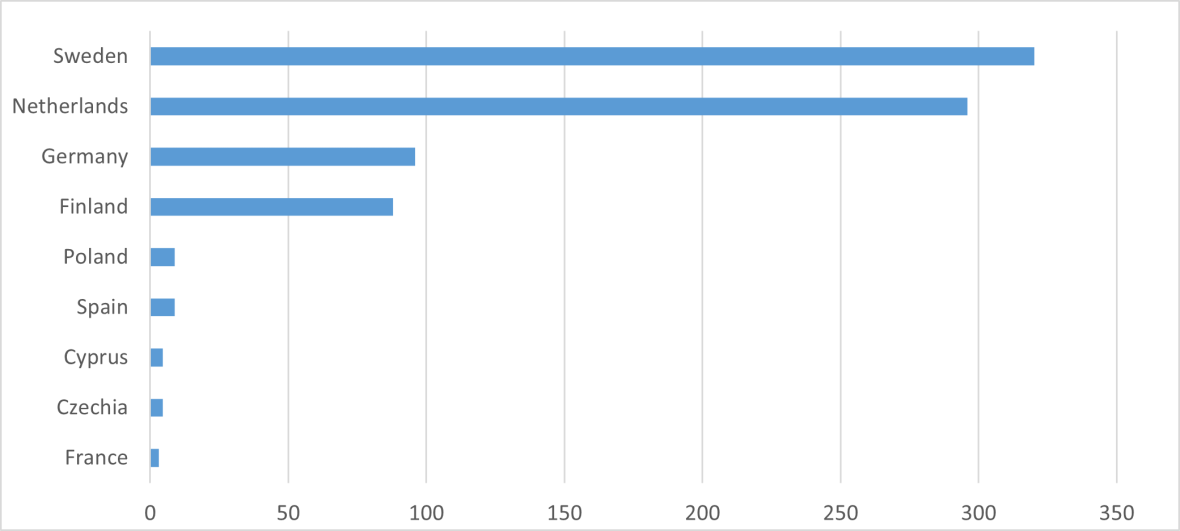The Political Economy of Green Hydrogen in Europe: Reinforcing Regional Inequalities?
25.09.2023

In February 2023, the EU presented the Green Deal Industrial Plan, in which it laid out its strategy for the green transition in industry and energy. Green hydrogen will be an essential cornerstone of this transition. The scale-up of renewable hydrogen production and its use in industry and transport has the potential to achieve decarbonization where direct electrification is not an option. Green hydrogen also offers opportunities to develop technological leadership and economic perspectives within a future net-zero economy.
Against this background, policy debates over the past years have focused on how the EU can compete with ambitious green industrial policies in China and, more recently, the US. With the Inflation Reduction Act, passed in August 2022, the Biden Administration is heavily subsidizing hydrogen production in the US. A key question is, therefore, how the EU can match these generous financial incentives and ensure that it attracts necessary investments in hydrogen-related value chains.
Less attention has been paid to how the EU’s hydrogen policy affects regional imbalances across EU Member States. In its Green Industrial Plan, the Commission argues that a “common response, anchored in EU policies and instruments, will be far more effective than the addition of 27 national approaches.” But does the EU deliver on its own call for an ambitious European industrial strategy for the hydrogen sector?
Firstly, the EU’s hydrogen policy relies on a relatively complex and fragmented approach. As part of the HYPAT project, RIFS Potsdam is developing a database of hydrogen policy in major economies that includes all policy instruments and targets enacted so far. Data collection in the EU reveals a very large number of different instruments, with initiatives within established programs predominating. For instance, the European Commission is providing limited funding for green hydrogen production and use as well as for hydrogen-related research and development (R&D). For this, it has extended the scope of existing funds such as the Modernization and Just Transition funds, which support the transition of those regions and Member States that have the lowest financial capacities. Moreover, governments are now also able to include green hydrogen projects in their Recovery and Resilience Plans, through which countries apply for money from NextGenerationEU, the EU’s crisis recovery package. No new sources of funding have been created. Instead, the EU has incorporated hydrogen-related spending in existing mechanisms. The largest single source of funding so far has been the Innovation Fund, which is financed by revenues from the European Emission Trading Scheme and provides grants for projects investing in green energy and industry. Here, hydrogen is identified as a key target.
In addition to these EU-level programs, the bloc has relaxed state aid rules to give Member States the possibility of subsidizing their national hydrogen industry. Usually, the EU prohibits this form of state intervention to guarantee a level playing field within its Common Market. However, in the face of the pandemic and the war in Ukraine, the EU has had to weaken its stance and now allows Member States to pass national recovery packages. As part of its efforts to foster the energy and industry transitions, the EU has extended exceptions for state aid to “sectors which are key for the transition to a net-zero economy.” The Temporary Crisis Framework, which was introduced to enable Member States to support their economies in the context of Russia’s war against Ukraine, has become the Temporary Crisis and Transition Framework and now allows governments to provide economic aid for the green transition.
In other words, the EU has chosen to rely on relaxing its rules on state aid, while providing only limited EU-level funding to promote the uptake of renewable hydrogen. This shifts the responsibility for making necessary investments in green hydrogen to other actors. Building electrolyzer capacities for the production of renewable hydrogen and achieving decarbonization in the steel or chemical industry will demand not only private but also public money, with national governments supplying most of the latter. Countries with large fiscal capacities such as Germany, the Netherlands, or Sweden will be at a considerable advantage here. Their national governments have significant resources to subsidize industries at home, unlike the governments of countries such as Romania, Croatia, and Greece. For instance, in July the Commission approved Germany’s request to support ThyssenKrupp’s efforts to accelerate the uptake of renewable hydrogen in its steel production by providing up to €2 billion in aid, while another €1 billion subsidy scheme for steel producer Salzgitter was approved in October last year . The Netherlands also got the green light for two hydrogen subsidy packages worth €1 billion in total. Most other Member States cannot afford such measures and rely on EU funds instead.
Existing EU-level funds, however, are also not accessed by all Member States equally. In most cases, governments themselves do not apply for grants. R&D projects are mainly carried out by public research institutions, while investment projects often rely on the initiative of private firms. Moreover, competitive funding programs like the Innovation Fund tend to favor large established companies over small start-ups. Although Innovation Fund calls include a section for small-scale projects, these receive only a small fraction of funding. The third call for small-scale projects provided 100 million in grants, while large-scale projects received 3.6 billion in total. Also, established enterprises have more resources, larger administrative capacities, and better networks. Our data shows that projects in Member States with large existing industrial sectors and an elaborated hydrogen strategy have been the largest beneficiaries of the Innovation Fund. To date, most funding for large-scale hydrogen-related projects has gone to Northern European countries: €320 million went to Sweden, €296 million to the Netherlands, €96 million to Germany, and €88 million to Finland. Countries like Spain, Poland, and Czechia have only received funding for small-scale projects, ranging from €3 to €8 million (see figure below).

Figure 1: Innovation Fund grants for hydrogen-related projects, 2020 – 2023 (last updated 23.09.23), by project location, in million Euros.
This is, of course, only a fragment of the full picture, as it is difficult to estimate the total amount of funding received by each Member State. Nevertheless, the trend is clear: The largest sums go to those countries that have large industries and high fiscal capacities. Poorer Member States are left with resources provided by cohesion programs such as the Modernization or Just Transition Fund. But these don’t provide dedicated money for green hydrogen.
Currently, there is a strong divergence between governments that have set ambitious targets for green hydrogen supply and demand and others that are at risk of falling behind. To our knowledge, only 15 out of 27 states have published a comprehensive hydrogen strategy. When it comes to implementation, the disparities are even more obvious. According to data from the International Energy Agency, 48 percent of green hydrogen projects within the EU that are currently in operation are based in Germany, another 11 percent in France, and the rest is spread across other Member States. Almost half have no hydrogen projects in operation at all.
These developments also contrast with the distribution of renewable energy potential across the EU, a key asset in the production of low-cost renewable hydrogen. As detailed in a recently published study conducted within the HYPAT project, many of the countries in Eastern and Southeastern Europe that exhibit significant potential for the production of surplus renewable electricity for green hydrogen production are not participating in the current market ramp-up. A renewable hydrogen economy could offer important incentives for firms in the steel and chemical industries to invest in Member States that offer the potential for cost-competitive renewable energy. Countries like Spain, Greece, or Croatia could not only sell renewable hydrogen and its derivatives within the EU but also develop downstream capacities for the production of green industrial products and build green industrial clusters. This could bring jobs and new perspectives to structurally disadvantaged regions, one of the key aims of European cohesion policy. With its Low-Income Communities Bonus Credit program, the Inflation Reduction Act pursues a similar aim. This additional tax credit provides up to 20 percent in additional financial incentives for renewable energy investments in low-income communities in the US.
The EU’s current strategy will, most likely, result in an important bias in favor of richer countries in the Union. Member States with large financial capacities will offer the financial incentives for their industries to stay, eroding opportunities for others to catch up and deepening regional inequalities. A common European approach to the green hydrogen ramp-up is needed to avoid this. In the first place, this would require more dedicated EU funds to be directed toward green hydrogen production and use where the potential is highest, rather than where governments have the biggest budgets. The EU Sovereignty Fund announced by the Commission at the end of last year could have been an important step in the right direction. In June, however, the Commission presented its plan for a Strategic Technologies for Europe Platform, which is supposed to replace the EU Sovereignty Fund. It would mostly reshuffle existing funds and provide only an extra €10 billion. This would not serve to reduce regional disparities.
The Commission also announced the establishment of a European Hydrogen Bank, which will conduct auctions for the deployment of green hydrogen production. This will allow hydrogen producers to bid for subsidies paid in the form of a fixed premium per kg of green hydrogen produced. The Commission has dedicated a budget of €800 million from the Innovation Fund for this purpose. To avoid a bias in favor of countries with strong fiscal capacities, the EU should ensure that these auctions are not combined with other subsidy schemes. An exception to this could be funding from the EU’s Cohesion Policy, which targets the EU’s structurally disadvantaged regions. The same also applies to the planned Carbon Contracts for Difference (CCfDs) to support hydrogen uptake in industry. The idea is to cover the difference between the conventional cost of production, including the CO2 price, and the cost of producing climate-friendly industrial products using hydrogen. The CCfDs would be awarded in a competitive bidding process, just like the production subsidies in the European Hydrogen Bank scheme. However, an official proposal by the Commission on the establishment of CCfDs is still pending. This raises concern that Member States themselves will move forward to implement CCfDs, as is the case in Germany. Then, the support for hydrogen uptake in industry would, again, be restricted to those countries with high fiscal capacities. Additional proposals, for addressing these challenges can be found in the recent HYPAT Working Paper mentioned above.
Finally, money alone won’t do the job. Lower-income Member States may lack innovative firms with the capacity to plan and carry out the projects they could finance. This calls for a more ambitious cohesion policy and for strong investments in infrastructure, education, and regional development, not only to counterbalance inequalities within Europe but also to realize the renewable hydrogen potential in those regions. The EU should acknowledge this as an opportunity to develop a more balanced and more efficient industrial policy for the hydrogen transition.

